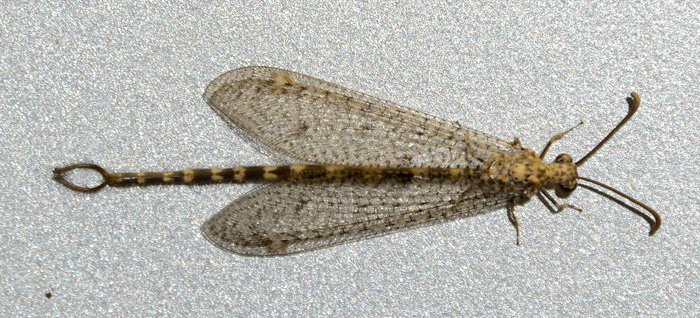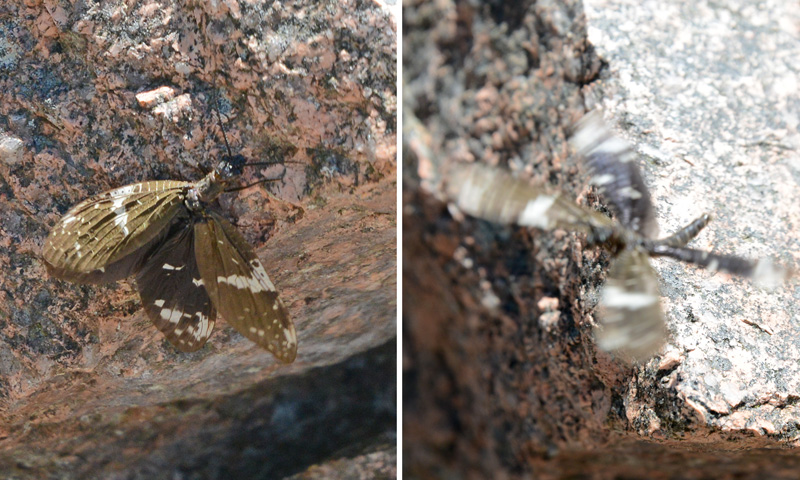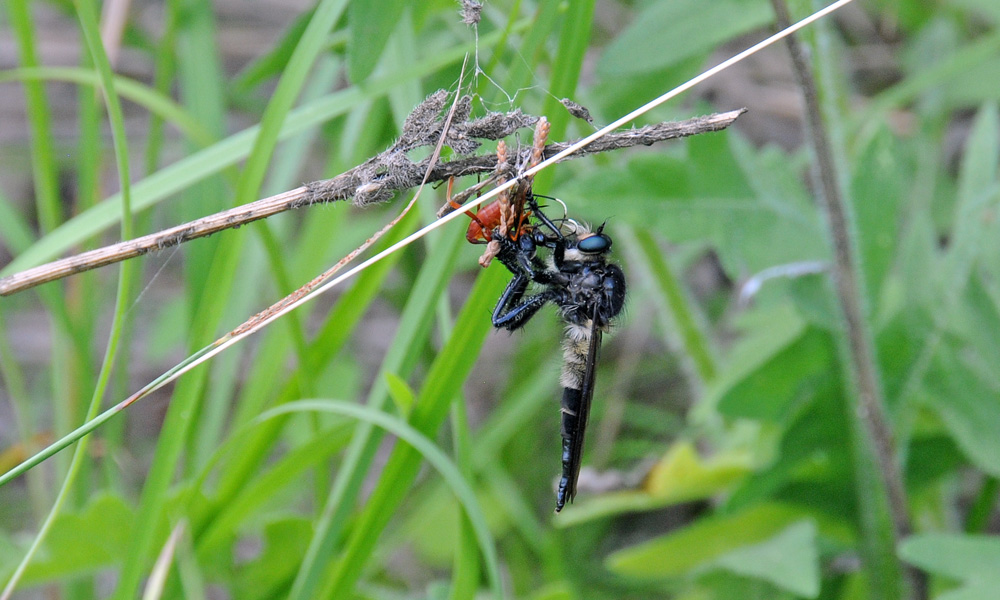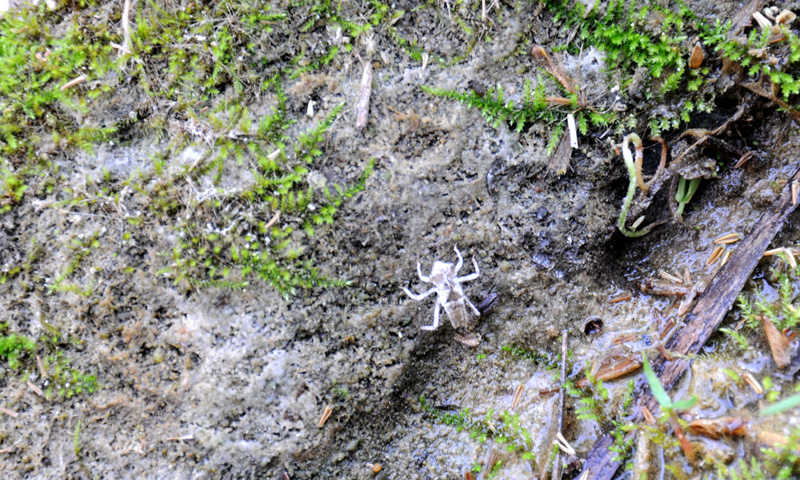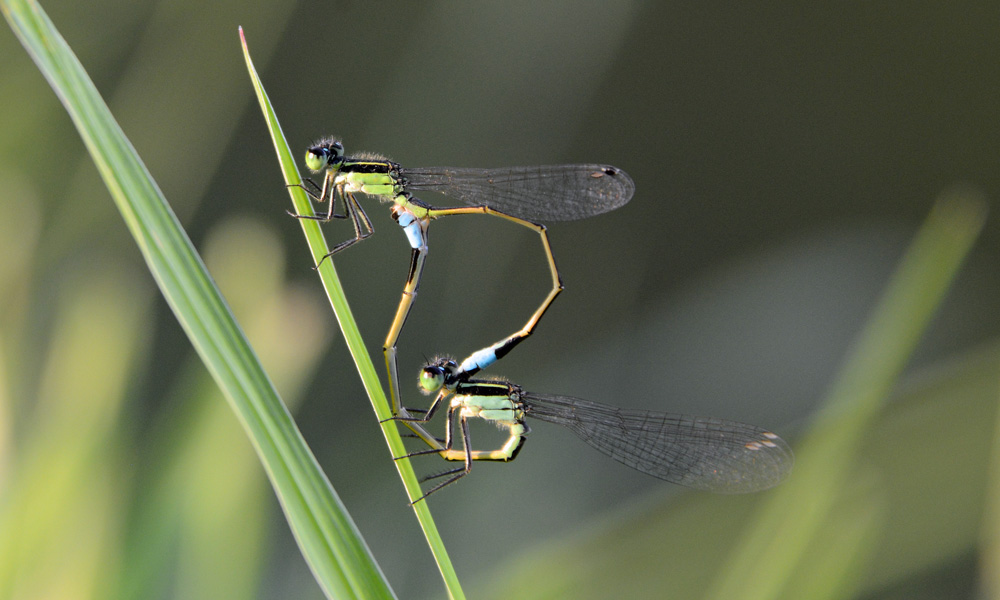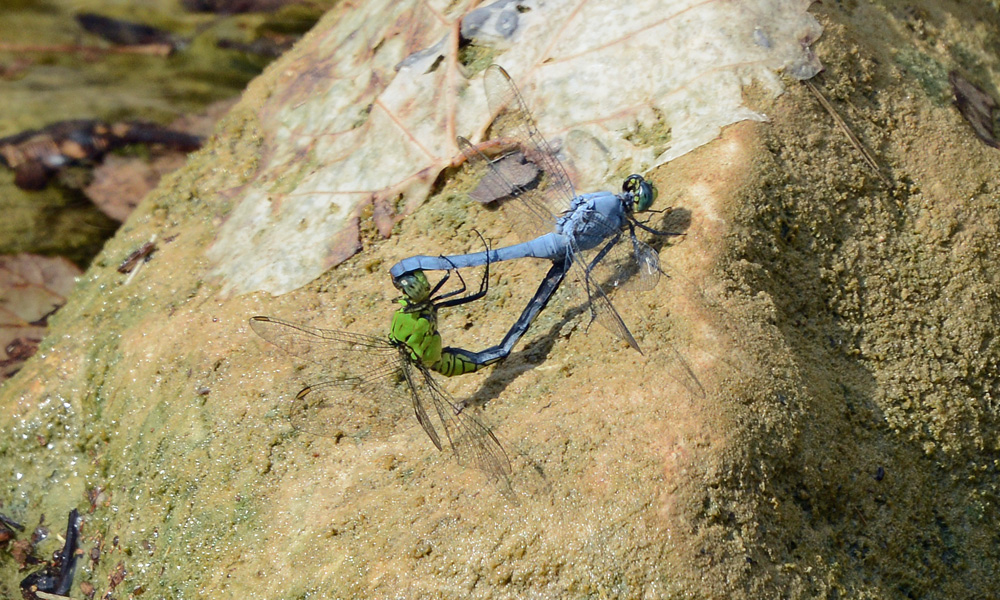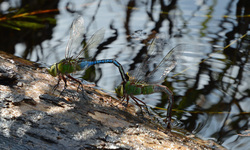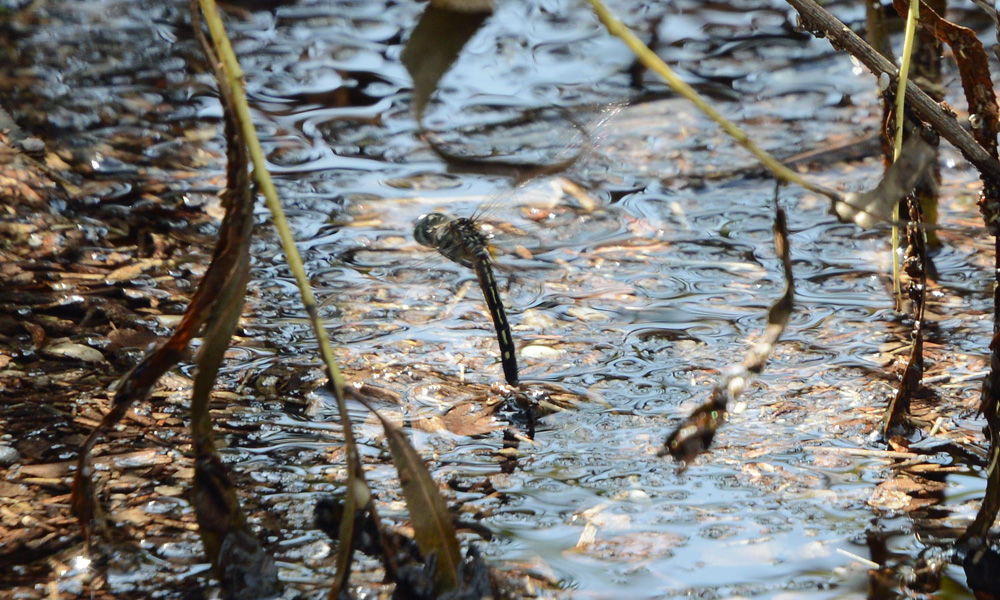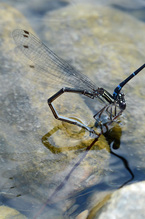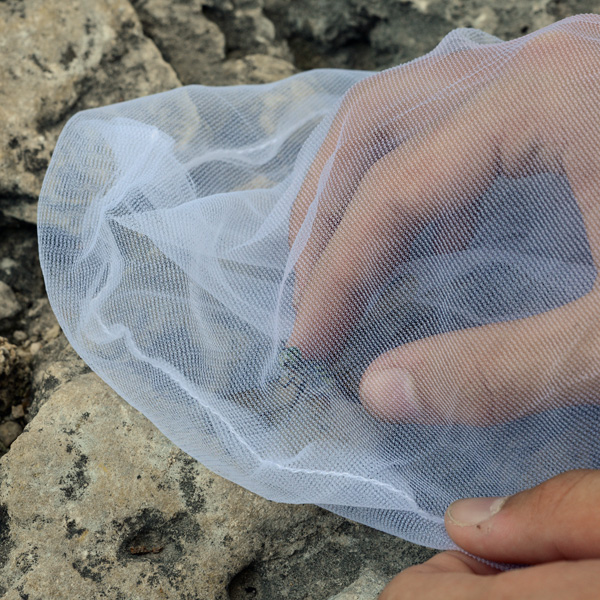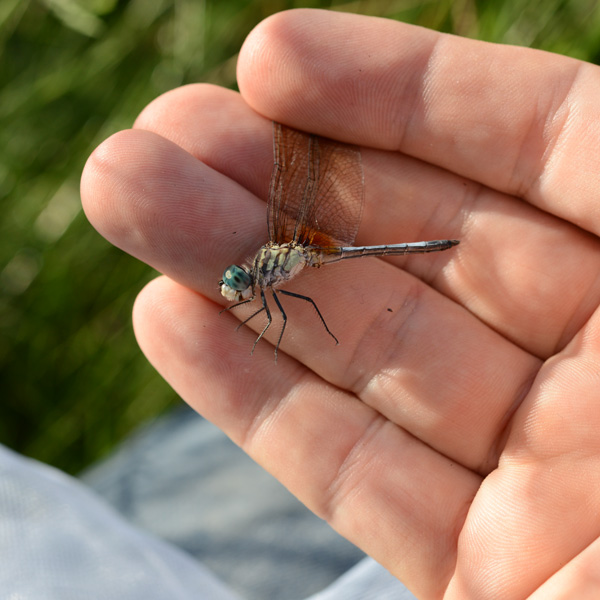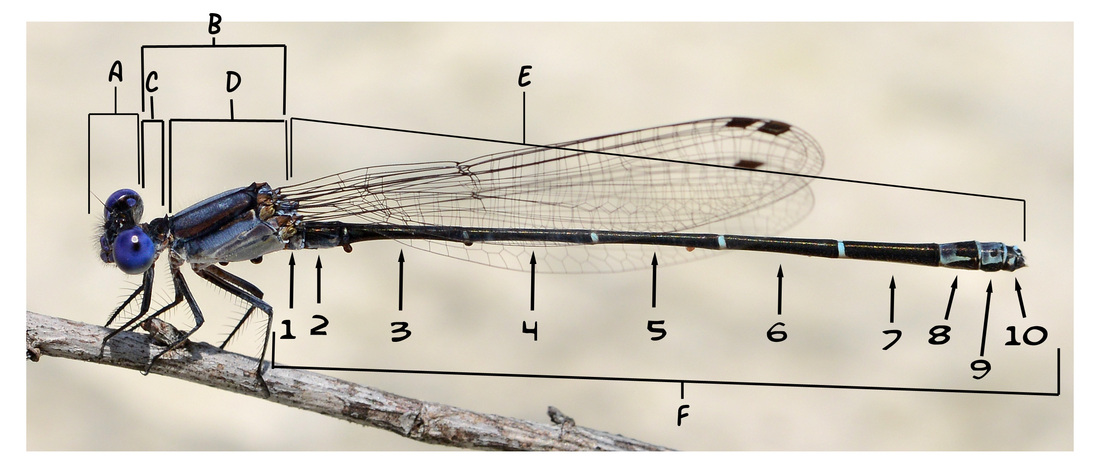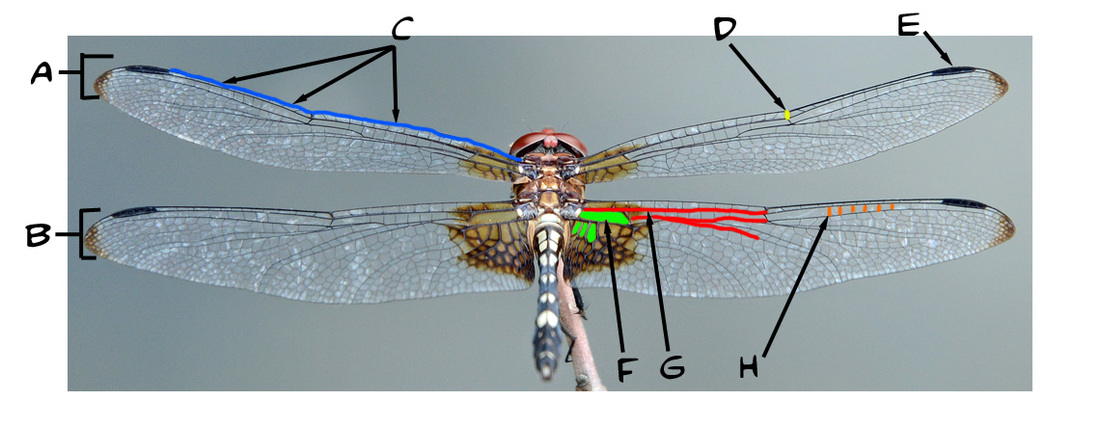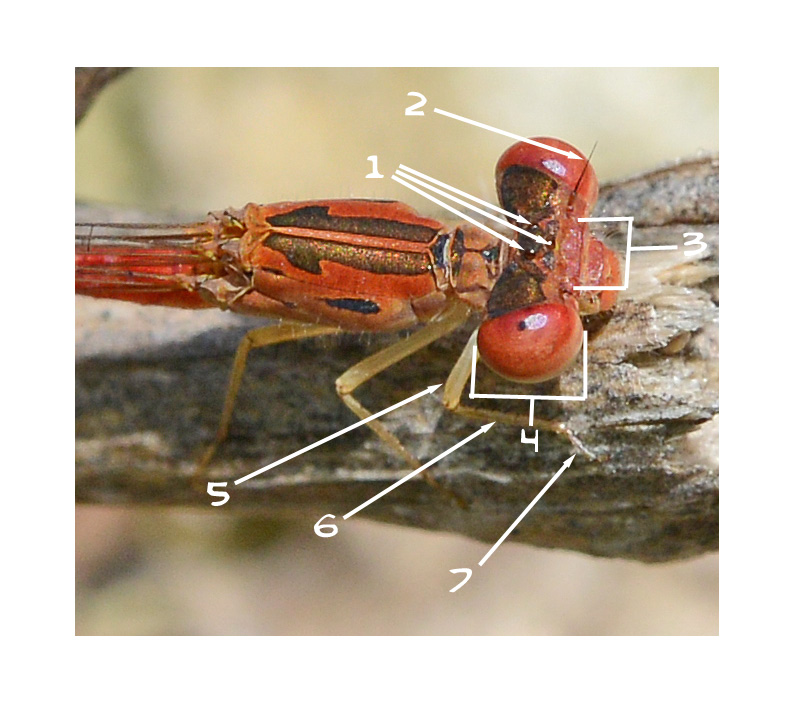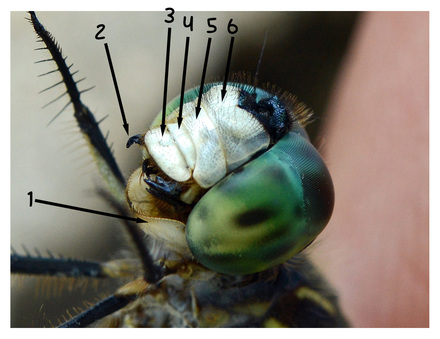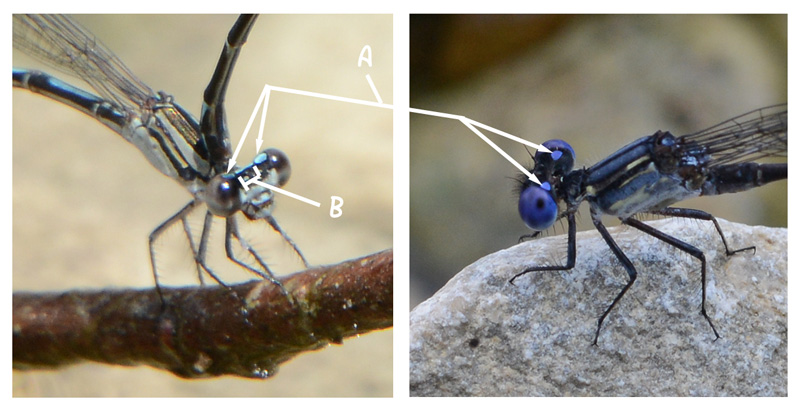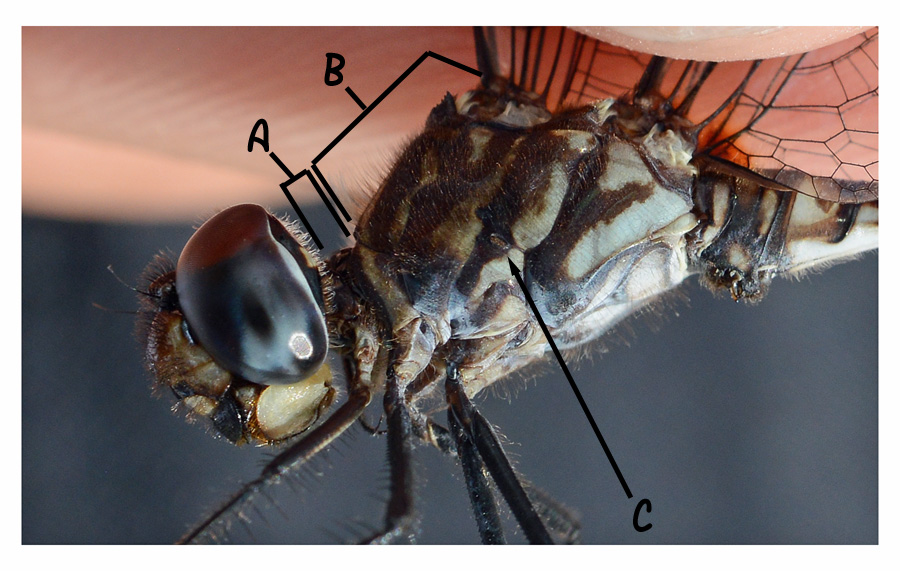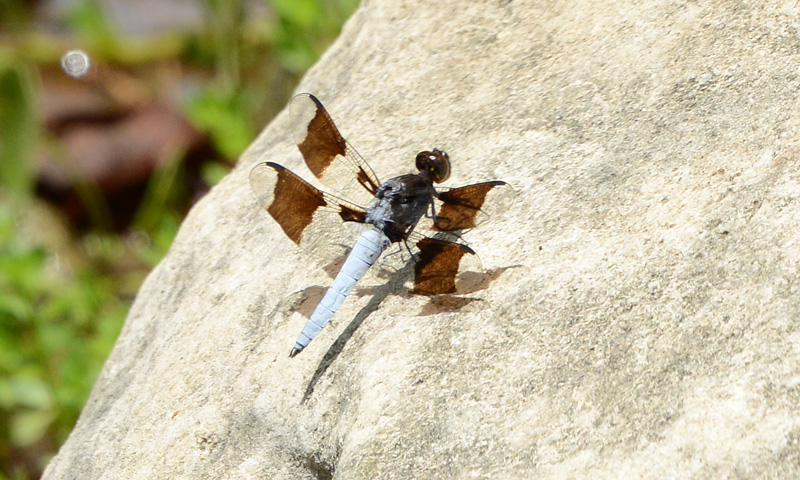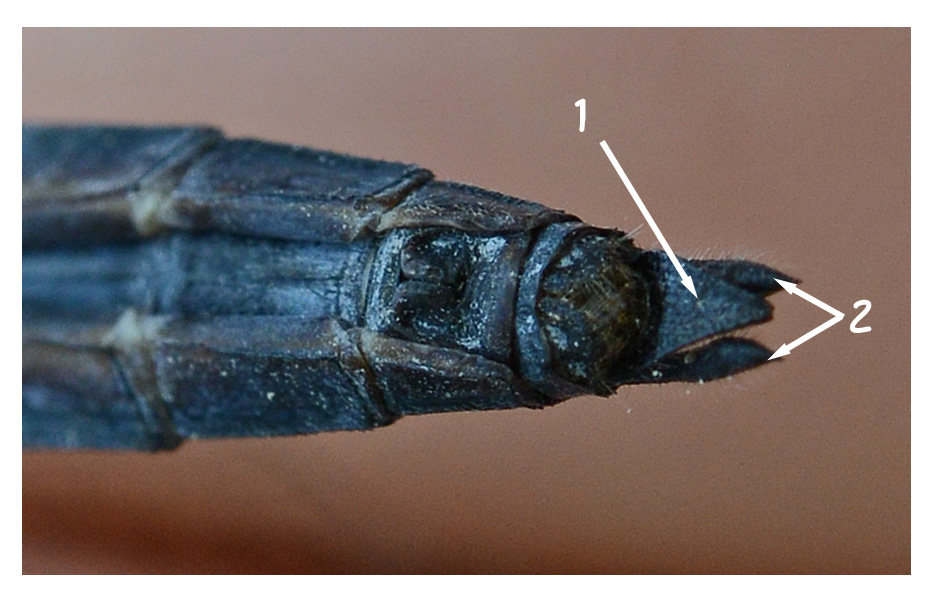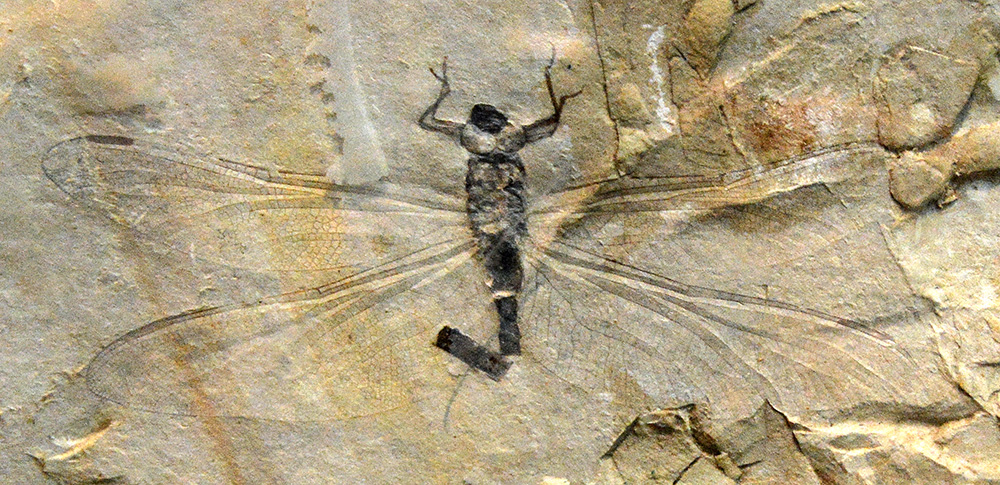Odonates (Damselflies and Dragonflies)
For images of other Dragonflies and Damselflies found locally while working on this honor, see our Odonata Gallery.
[Last Updated Sep. 28, 2013]
[Last Updated Sep. 28, 2013]
What are Odonates?
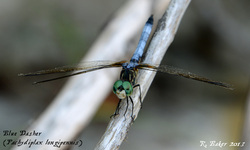
Odonata is the order of insects that includes dragonflies and damselflies. The name stems from the greek root word odonto, meaning tooth, a reference to their large mandibles. (You may have seen the root odonto before, perhaps if you visited an orthodontist. Ortho means straight, or to make straight, odont means tooth, and the ist means a person who does that, so an orthodontist is a person who makes teeth straight.) Like all insects (Class Hexapoda or Insecta), the odonates have two pair of wings, six legs, a pair of antennae, and a body divided into three distinct segments; the head, thorax and abdomen (see the anatomy section). The odonates have large, compound eyes, and primitive wings that cannot be folded smoothly over their abdomens (as opposed to the wings of beetles and many other insects). However, each wing is independently controlled and maneuverable, allowing the odonates to hover or even fly backwards.
See our page of odonates of Texas to look at some of the common species we see around Austin. A few other flying insects look similar at first glance to dragonflies and damselflies, including the dobsonflies, owlflies, fishflies, robberflies and antlions, but a second look should make the differences obvious. There are more than 5000 species of Odonata world wide. In North America, there are more than 600 species, with seven families of anisoptera (dragonflies) and four families of zygoptera (damselflies) represented. In Texas there are 67 damselfly species, and 140 dragonfly species, making 207 total (though some counts list only 203 species). There are at least 111 recorded species of odonates in Travis County alone. Go near almost any body of water here in Central Texas, in the Austin area or even the water right downtown and you are almost certain to find at least a few odonates. Their ubiquitousness, their fairly large size and colorful bodies, their generally predictable flight patterns and their tendency to sit and perch make them easy and fun to observe. They are voracious predators, eating mosquitoes and other insects, so they are more helpful than harmful. They also have some interesting characteristics that make them fun to study (some dragonfly larvae can use a form of jet propulsion underwater by rapidly squeezing water out of their anus!). They are beautiful little jewels of the air; showcases of God’s creative power.
Depending upon the classification system used (science can be confusing like this at times), the Odonata are divided into two (or three) categories. The dragonflies are in the suborder Anisoptera (from anisos meaning unequal and ptera meaning wing, so dragonflies are “unequal wings” referring to differences in the forewings and hindwings), and the damselflies are in the suborder Zygoptera (zygos meaning a yoke, ptera meaning wings, so damselflies are “yoked wings,” referring to the way they are paired). Some classification systems have a third category, the Anisozygoptera (unequal yoked wings), which comprise primarily extinct Odonata, but may include two species, one from Japan and the other from the Himalayas. These look somewhat like a cross between a dragonfly and a damselfly, hence their name. At the bottom of the page for the 2012 International Congress of Odonatology, you can see Epiophlebia superstes, which is the Japanese species of the Anisozygoptera. If you look at it, you will see its head and wings are more like a damselfly, while its body is more like a dragonfly. Dragon? Damsel? Which is Which?
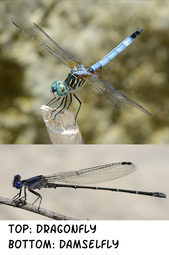
So how can you spot the difference between damselflies and dragonflies? The first obvious difference is usually size and apparent heft. Damselflies have very slender bodies, and are usually no more than an inch and a half long. Dragonflies have much more robust bodies that can reach three inches or more. In general (aside from the spreadwings), damselflies hold their wings folded together above their abdomen when perching, whereas dragonfly wings are spread outward from the body. (If you look at where the wings attach to the body, it is easy to see why their wings are held in a different manner). The eyes of damselflies usually do not touch, whereas the dragonfly eyes are generally very large, and touch together near the top of the head. Damselfly wings are usually the same shape whether forewings or hindwings, whereas the hindwings of dragonflies are usually wider basally (at the base, nearest the body) than the forewings. Dragonflies are usually more robust fliers than their diminutive cousins the damselflies.
Life Cycle of the Odonata
The video below follows the life cycle of the odonates. It was posted on YouTube by Willem Berents, from the Netherlands, who wrote the script and did most of the filming.
Odonates are considered hemimetabolous (hemi means half, metabole means change), meaning that they have an incomplete metamorphosis compared to some other insects. They have a three-stage life cycle; egg, nymph and adult. Odonate eggs are usually laid on, in or near the water. When they hatch, the young larvae (called nymphs or naiads) live underwater and breath through gills (some dragonfly larvae draw water in and out the anus over the gills to breath!). The larvae have a specialized mouthpart called the labium, a clawed appendage under the chin that is used to help capture prey and hold it while the naiad chews on its meal with its sidewards-opening mandibles.
[The video below from Nature1UpClose shows the labium in action] Odonate larvae molt several times underwater, breaking out of their hard skin, expanding their body, and growing a new hard skin. Each larval stage is called an instar, and odonates can pass through 9-17 instars before they are ready for their big change. After months (or in some cases years) of development underwater, the naiads are ready to climb to the surface and crawl up the stalk of an emergent plant or onto a rock or log to complete their metamorphosis. Here they will break out of their skin one last time. While this occurs, sometimes you can see what look like thin white threats pulling out of the dragonfly’s sides. These lined the tracheal tubes or spiracles, and when they pull out, they allow the dragonfly to breath through its spiracles. (For more on dragonfly respiration, see the section How do Odonata Breathe.)
The empty old skin is called the exuviae, and you can sometimes find these on plants, in the water or near the shoreline of streams, ponds and lakes. Another short video on the basic life cycle of a dragonfly is available at http://www.youtube.com/watch?v=Ezq_JWd1Sd8.
Out of the Water, Into the Air
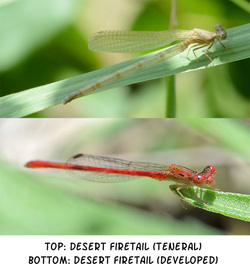
The newly-hatched dragonfly or damselfly (called a teneral while it is still soft and largely colorless) will force water into the veins of the wings to expand them, expand its abdomen to its full length, and then wait for its exoskeleton to harden. During this process the odonate will gain its color and characteristic shape. When dry, it is off to hunt and mate. Grown odonates are predators, usually hunting flying insects. They are incredible flyers to watch. Their broad wings allow them to glide, but they can also dart quickly in different directions, chasing down prey or a mate. Many odonates are crepuscular, meaning they are active and feed around dusk, so if you are looking for dragonflies, consider checking the stream or pond at different times of the day. You may see different species.
Odonate males seek receptive females for mating. When the male finds the female, he will grasp her neck or head with his claspers, which comprise the paired cerci and the singular epiproct (in dragonflies) or the paired paraprocts in damselflies. Once clasping the female, the male dragonfly will move its sperm from a genital pore at segment 9 to a secondary genital at segment two. The female will then bend her abdomen around to match her genital at segment 8 with the male’s segment 2. This creates the so-called wheel position, and you can often see damselflies flying around in this position. After mating, the female will deposit the eggs.
In some species, the male remains with the female, still clasping her head or neck while she deposits her eggs on or near the water. In other species, the male releases the female, and she lays the eggs herself. The female may drop her eggs in the water, place them near floating vegetation or in the mud near the shore, or even insert them into emergent plant stalks. When the eggs hatch, the cycle begins again.
Can I Catch Them?
If you would like to catch a dragonfly or damselfly for closer study, you can use a butterfly net (or sometimes even your own hands). As with most insects, sweep the net from behind. Dragonflies and damselflies often have a perch they use over and over, or a flight path along the stream or bank they follow repeatedly. If you watch for these behaviors, you can anticipate their next actions, and be ready with the net. Once you have one caught, you can remove them from the net by holding their wings together gently over their thorax. This will allow you to look more closely at their various body parts and colors, and you may even see them open and close their three-part mouths. Don't hold them for too long, and be careful not to injure their wings. When you are ready to release them, set them on some vegetation or a rock or log. Sometimes they will fly away immediately, other times they will take a few moments to get their thoughts in order, and this offers you more time to study them, including seeing any patterns on their wings.
|
Anatomy (click images to enlarge)
So What Are All These Parts?
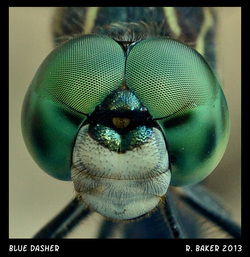
If you look closely at an odonate head, you will see the large compound eyes made up of numerous tiny facets called the ommatidia. These large eyes may be two-colored, and can see in the visible spectrum, ultraviolet and polarized light. You may also notice three smaller spots near the top of its head. These are the ocelli, simple eyes used for light detection. Together, this gives the odonate a very sophisticated and sensitive visual system. The mouth of the odonate is made up of three main parts, the labrum (or upper lip), the labium (or lower lip, which is also used to help catch prey) and the mandibles, the jaws that open side-to-side (as opposed to up-and-down like your jaws work). The front of the head, or face, is called the frons. Looking at the color of the frons is one of the marks to look for when trying to identify an odonate. Other markings on the head may include the eyespots (also called postocular spots), which are marks of color behind the eye on top of the head (letter A below), usually on damselflies, and the occipital bar, a line of color across the top of some damselfly heads (letter B below), separating the eyespots.
The thorax (the middle body segment where the legs and wings attach) is divided into two parts; the prothorax (letter A below in the picture) which holds the first pair of legs and has the neck attached, and the pterothorax (letter B in the picture below), where the middle and rear leg pairs and the wings attach. The Pterothorax is the fusion of the mesothorax and metathorax. On the side of the thorax (and abdomen), you can sometimes see what appears to be a small spot or opening. This is a spiracle (letter C below), used for breathing.
The color pattern on the pterothorax is another characteristic to look at when trying to identify the odonates. But be aware that in some species, there is a difference in the appearance of the male and female (sexual dimorphism), and in several species, a pale white or bluish waxy “bloom,” called pruinescence, may form over all or part of the abdomen and thorax, often hiding the color patterns on the body of the odonate. The pruinescence on the Common Whitetail below helps to give this dragonfly its common name.
On the wings of odonates, the veins are easily seen (see the picture above in the anatomy section). These give strength and stability to the wings. The vein along the leading (front) edge of the wing is called the costa. The spaces between veins are called wing cells. Near the tip of the wing on many odonate is a darkened cell called a pterostigma (literally meaning wing spot), which is believed to add further stability to the wings in flight. The front wings, closest to the head, are called the forewings. The rear wings are called the hindwings. The wings can be clear, or have various coloration patterns. Dragonflies referred to as saddlebags, for example, have darkened spots near the base of their hindwings, looking at quick glance like they are hauling saddlebags over their abdomens.
The abdomen of the odonates is made up of ten segments. Sometimes identification requires looking for specific patterns on specific segments, something not easy to do with a moving damselfly. On the tenth segment are the claspers, including a pair of cerci, and either a singular epiproct (in dragonflies) or paired paraprocts (in damselflies). These are used in part for mating. Below, you can see the epiproct (1) and the cerci (2) on the abdomen of a dragonfly. How do Odonata Breathe?
You may have heard someone say that insects do not breathe. Well, that is not entirely true. Insects may not breathe in the same way we do (the diaphragm muscle compressing and relaxing the lungs, pumping air in and out the the mouth and nose, the lungs being the place of oxygen, carbon dioxide and other gas exchange into the blood stream, the blood taking the oxygen to the cells for use). But Odonata certainly do breath. As we saw earlier, the Odonata naiads breath underwater with gill-like structures. In most damselfly larvae, these gills are leaf- or oar-like appendages near the rear of the nymph, with dragonfly naiads the gill-like structures are usually inside the abdomen, and water is brought in and out the anus over these gills to facilitate gas exchange. But adult Odonata do not have gills. If you saw in a video of the dragonfly emerging as an adult, there were strange white tubes that were pulled out of the body, leaving small holes on the surface of the adult dragonfly. These holes are called spiracles, and they connect to ribbed tubes called trachea that then branch into even thinner smooth tubes called tracheole that reach around to the cells inside the dragonflies and damselflies. It is through this system that the Odonata “breathe.” Oxygen moves to the cells via these tubes in different ways. The most basic way takes advantage of the concentration gradient, a fancy way of saying that gasses tend to move from areas of high concentration to areas of low concentration. The oxygen content in the air around the dragonfly is higher than the oxygen content at the end of the trachea, so oxygen molecules move into and through the trachea to the cells for use. Similarly, the carbon dioxide level in the trachea near the cells is concentrated much higher than general carbon dioxide levels in the air, so the carbon dioxide tends to move out of the trachea and spiracles into the air. But Odonata also breathe in a less passive way. Studies have shown that they (and several other insects) can expand and contract the trachea, drawing air in or forcing it out. There are also air sacs connected to some trachea, and these can also help actively regulate the movement of air to and from the cells. In general, the oxygen is delivered directly from the tracheal system to the cells, without the use of a liquid transport medium like blood. But in some cases, there is a little transfer of the oxygen and carbon dioxide molecules via the hemolymph (sort of insect blood, though it doesn’t really have much of a pumping circulatory system like other animals). For cells that need a lot of oxygen to work (like the motor cells that power a damselfly’s wings), there will be a higher concentration of tracheole, whereas other cells may accept a more passive diffusion of oxygen. One other interesting note is that some studies have shown certain species of dragonflies laying their eggs completely under water. They “breathe” underwater by bringing a small air pocket around their body, allowing them to keep breathing air through the spiracles.
Ancient Odonates
Dragonflies appear in the fossil record from the Pennsylvanian onward. Some fossil dragonflies have a wingspan as broad as 30 inches. Many fossil dragonflies and damselflies are little different than those you can go out and see today. The dragonfly below, Chrysogomphus beipiaoensis, is on display at the Beijing Museum of Natural History. It was found in Liaoning province, in northeast China, and is dated to the late Jurassic.
Odonates Pathfinder Honor Requirements
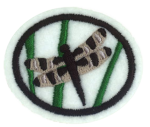
1. What are Odonates?
2. Know how many species of damselflies and species of dragonflies are in your Country (or State/Provence) and Continent and Worldwide. 3. How do dragonflies and damselflies differ? 4. What separates Odes from other insects? 5. What other insects look a bit like odes? 6. Describe and draw the life cycle of an ode. 7. Know the following terms regarding Odonates:
8. Of what value are odes and why should we study them?
9. Identify and observe at least 15 species of Odonates. Record their location, habitat and date of finding. 10. Demonstrate how to properly catch and release an Odonate without injuring it.
|
Additional Resources and Information
|
Books:
Videos:
ID Helps, Checklists, and Galleries:
|
General Information:
Anatomy and Life History:
|
